Chrysanthemum is also known as Mums, Glory of the East. It is one of the most cultivated garden flowers and is probably second only to the Rose in popularity. Chrysanthemums are hardy garden flowers and house plants that come in a variety of colors. Most mum plants are easy to grow with their basic requirements being the full sun, rich soil, good drainage, and good air circulation.
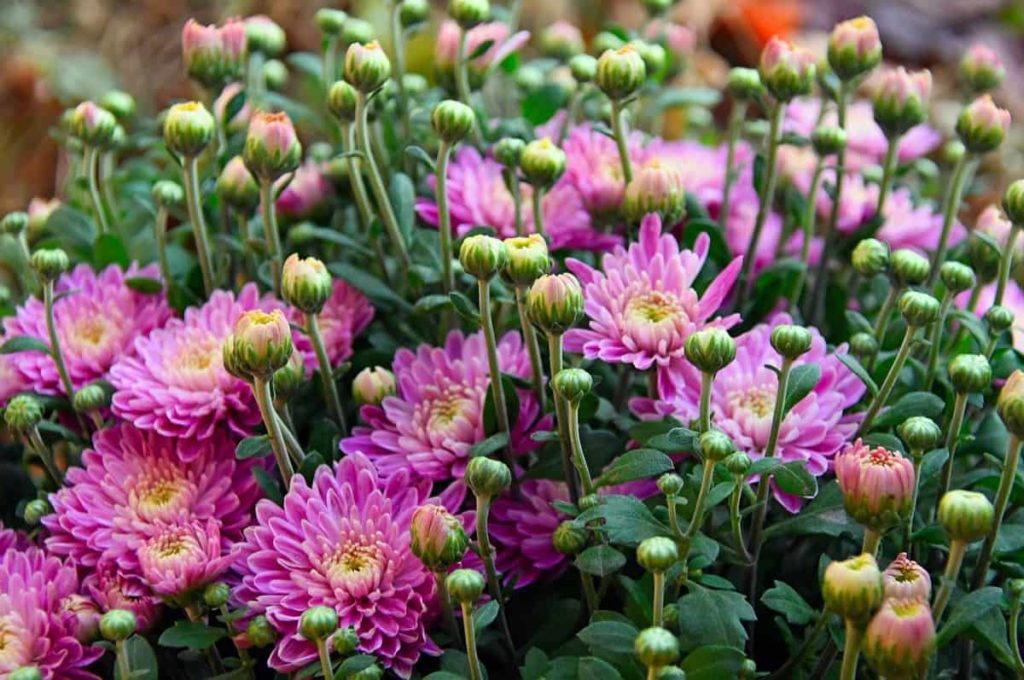
Chrysanthemum is a member of the Compositae family and is available in a wide range of stunning colors, shapes, and sizes. Chrysanthemum flowers range from bright white to dark bronze, and dark green leaves characterize hardy plants.
How to keep Chrysanthemums blooming
How to care for indoor mums
Most people aren’t aware of the fact that mums are usually rooted when you buy them. This means that mums need a bigger pot to keep them healthy and active. Be sure to use a quality potting soil mix, placing a layer on the bottom before breaking the roots and repotting your mum in a new pot. Find a window that allows at least four hours of direct sunlight daily. You don’t want to overwater your mums.
However, the worst thing that can happen is for them to become too dry. Deadhead often for long-lasting blooms. Removing wilted flowers and dead stems/leaves makes your mums look prettier and helps your plant bloom longer. Once your mums stop blooming, you can put them outside on the ground after the weather warms up. Mums will only bloom once indoors, but keeping them green until you transplant them outside will allow you to enjoy them next season.
When do Chrysanthemums bloom?
Knowing when Chrysanthemums bloom is easy as long as you know what kind you have. Early blooming moms can start flowering in the last days of July. Most mums are early fall flowers that begin blooming in September. Some late-blooming mums won’t bloom until October. Different varieties will bloom at different times. When you buy mums, it should be easy to find specific information about them. This will ensure that you know what to expect so that you can do all you need to help mums thrive.
Tricks and tips if mum is not flowering
Chrysanthemums are very easy to care for and require very little maintenance. Wait until spring to cut the plants. Cutting the plant back will force the plant to produce more branching stems, which will provide more room for buds to form. Some gardeners cut them to 2 inches (5 cm) above the ground, while others opt for gentle tipping. Chrysanthemums will benefit from a liquid fertilizer in early spring.
In case you missed it: Chrysanthemum Farming in Polyhouse for Maximum Profits
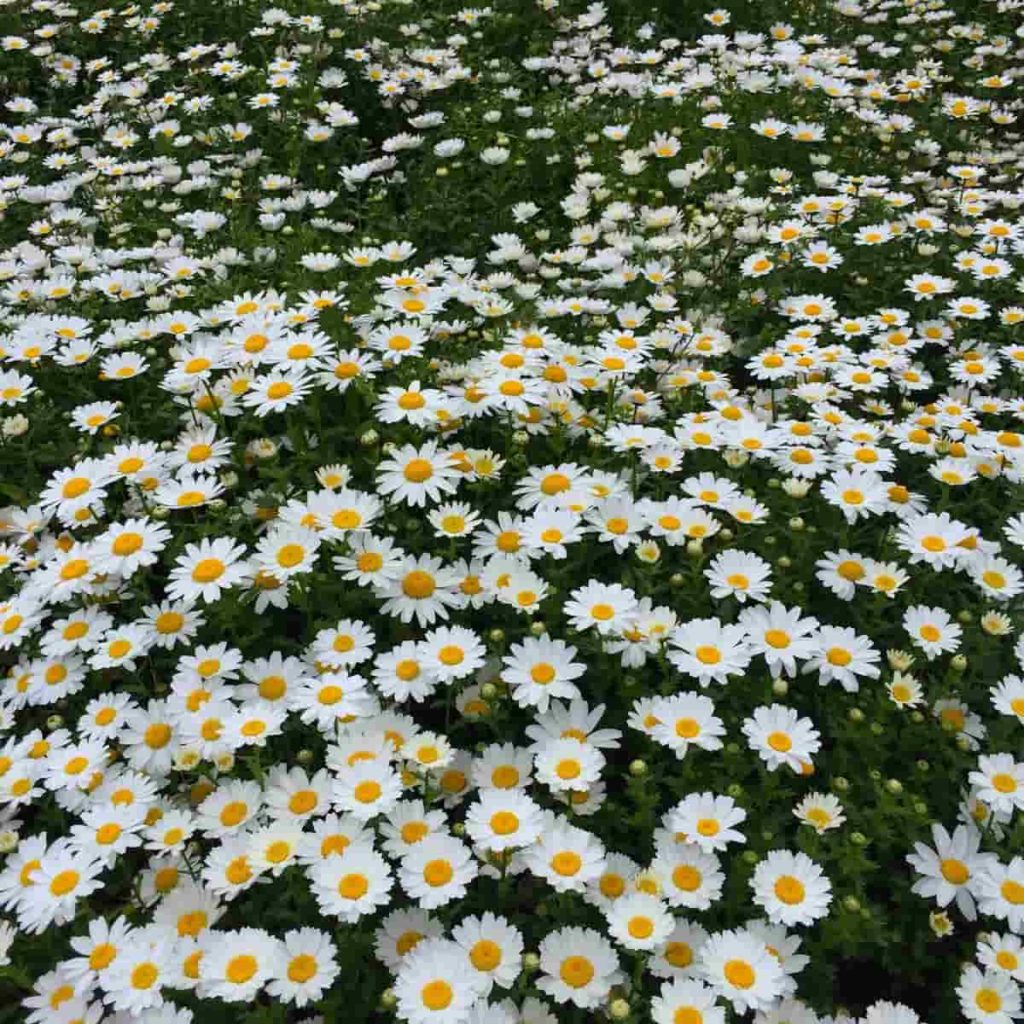
One secret to encouraging flowers on mums is to pinch them back. This means removing the initial buds with pruning. Cut back the top growth in the area where the front branches grow, and the plant will produce more stems and larger, fuller buds. Just be sure not to pinch the plants two months before they are expected to bloom, or you will remove all the buds and end up with a plant that will fail to flower. Prune Chrysanthemums to promote growth. Pruning can encourage bushy growth and more flower buds.
Pinch the tops of the stems once a month when the plants are about six inches tall. Protect your Chrysanthemums from pests. Mums are susceptible to pests such as aphids and diseases such as powdery mildew. Prevent the spread of insects and molds by spacing your plants in the garden. Allow good air circulation between the leaves, and water the plant close to the ground, so the leaves don’t get wet.
Caring for outdoor mums
Like indoor mums, plants outside or in the garden need sunlight. Organic soil or compost will produce strong, healthy mums.
Give mums plenty of space
It’s wise to plant your mums 18 inches apart from other plants to give their roots room to spread.
Water, but not too much
Water under plants at the soil surface, as overwatering flowers and leaves, can cause mildew. After the first week, when you want to water more often, ensure the mums get an inch of water each week.
Deadhead
As mentioned above, removing wilted flowers and dead stems or leaves will help your mum bloom longer. In cold weather, your mums may need to be mulched using leaves, wood chips, or straw. The mulch should be about three or four inches high and should surround the entire base of your mums. Don’t worry if your mum gets a cold. Just prune them back to the point where the stems are just an inch above the ground, and leave the mulch around the plant.
How do you make mums bloom longer?
- Buy mums with buds: If the mums you buy are already in bloom, you have no way of knowing how close they are to maturity. Instead of buying flowers in full bloom, look for plants that have blooms. Have plenty of buds so you can enjoy the full bloom period.
- Protect mums from the sun: Mums are usually full-sun plants, but sunlight makes them bloom more eagerly. Flowers longer. To do this, place the plant in bright indirect light rather than full sun.
- Water mums from the bottom: Protect your mums from rain, and water them carefully without splashing the foliage or flowers. This can cause spots and brown flowers.
- Keep mums cool: Warmer temperatures also encourage flowering, while cooler temperatures help mums bloom longer.
- Plant hardy perennial mums: If you love fall mums, try filling your garden with hardy perennial varieties that will come back big and glorious every year. Perennial mums typically have a blooming season of about a month in late summer or fall, then die back in winter and re-grow in spring.
In case you missed it: Chrysanthemum Cultivation Information Guide
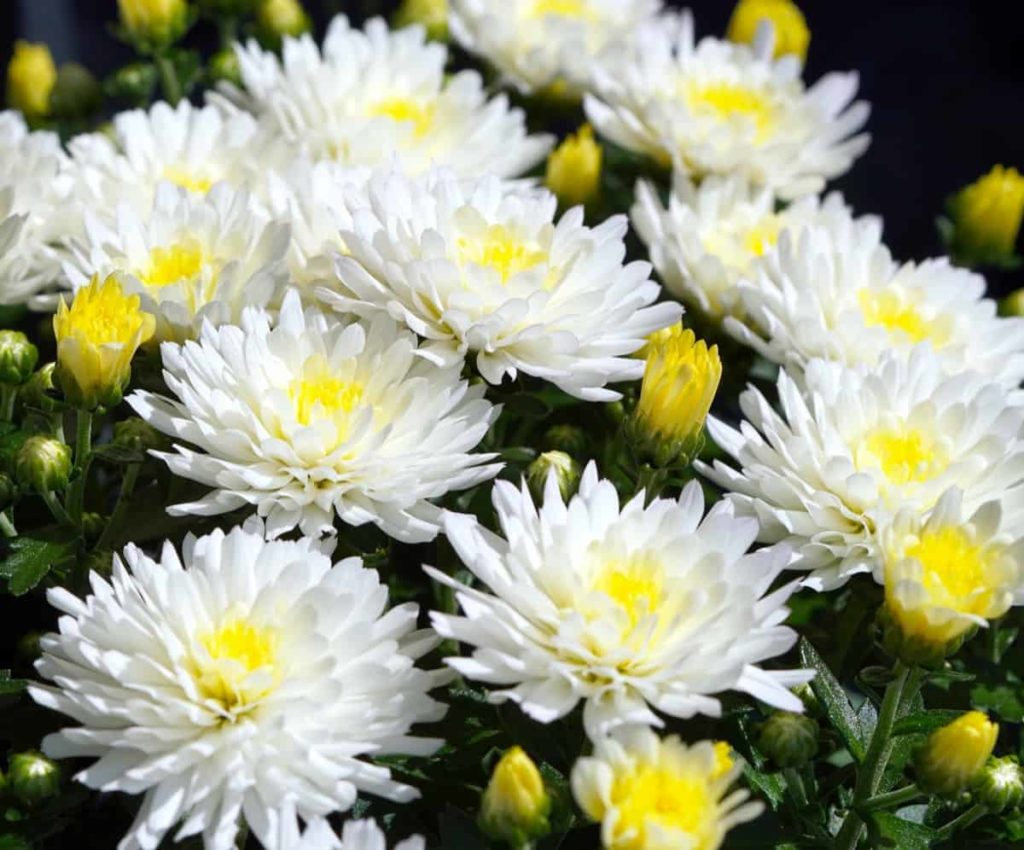
Why aren’t my mums blooming?
If you plant them in areas that receive less than six hours of direct sunlight, mums will stop blooming. Additionally, waterlogged or wet soil can cause pests, diseases, and root rot that inhibit flower growth. Finally, forgetting to pinch mums in the spring can also affect the importance of flowers.
The common reasons for mums not blooming include:
- Improper lighting
- Improper watering
- Waterlogged soil
- Pests and diseases
- Forgetting to pinch them after blooming
Tricks to get more Chrysanthemum blooms
- Mums need care to bloom normally. Keep your mums in a sunny spot in your home. Find a window that lets in a lot of sun and ensure it gets at least four hours of direct sunlight a day. Keep the soil moist.
- Deadhead often for long-lasting blooms. Removing wilted flowers and dead stems and leaves not only makes your mums look prettier, but it helps your plant bloom longer because you have dead flowers and stems competing for water and nutrients. They don’t do what new buds and flowers need to thrive. Once your mums stop blooming, you can put them outside on the ground after the weather warms up.
- Mums will only bloom once indoors, but keeping them green until you transplant them outside will allow you to enjoy them next season. When planting mums, place them in a location that receives at least six hours of sunlight per day. Too little sunlight can reduce flower bud production and result in smaller, weaker blooms. Adequate sunlight also ensures that moisture does not remain around the mums, which can lead to mildew that can harm the plant.
Big secrets to keep your mums blooming
Buy pre-blooming mums
Getting the most out of your mum’s starts when you buy them. Unfortunately, mums who are already displaying their flowers are not the best choice to take home. If they are in full bloom mode, they probably have two weeks or less of significant color left. Mums that are already covered in blooms can be an ideal choice for a quick display of color at a fall special event, but if you’re looking for plants that will last all fall, avoid plants that are already flowering.
Even partially blooming mums in stores should be avoided if possible. Mums at this stage will not only last longer but can be better managed to maximize their blooming period. Hardy mums can be saved and planted to regrow next year, making your purchase even more economical.
In case you missed it: 14 Key Rules for Successful Backyard Farming/Gardening: A Beginners Profitable Guide
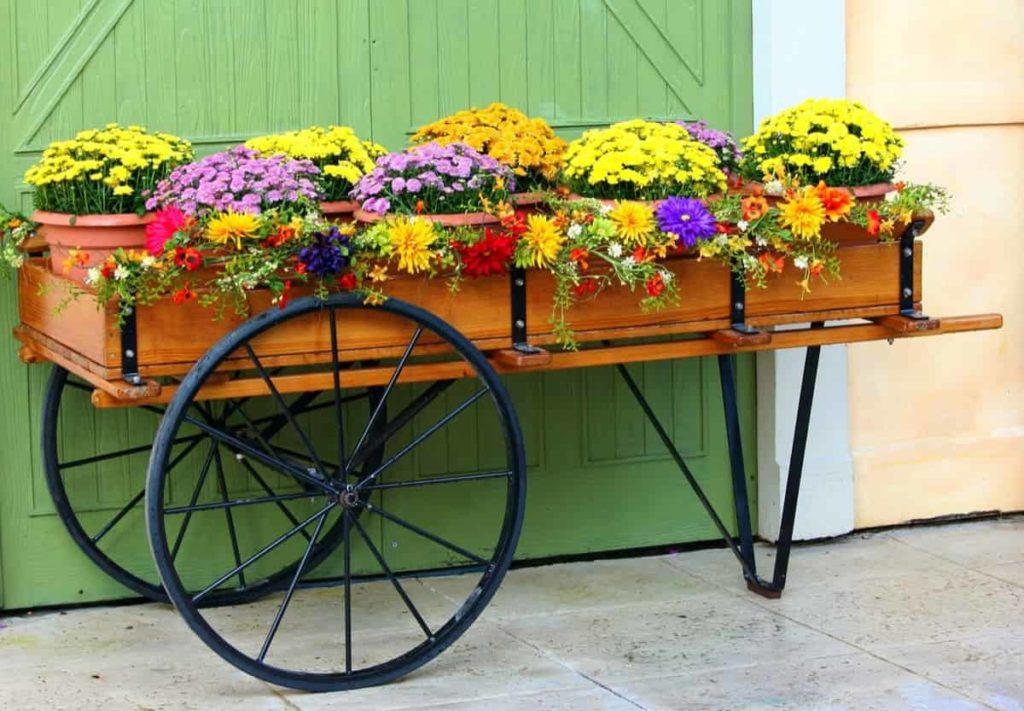
Buy blooming mums, not blooming mums
Large, beautiful plants may look attractive throughout the blooming store but die out quickly. Once the mums are in full force, they can take up to two weeks to be at their best. And, unless you need them for an immediate display, it’s best to avoid them together. One of the best ways to keep mum throughout the fall season is to buy it before its prime. Look for plants that are full of buds or just beginning to bloom. At this point, the mum is just starting to explode with color. And that means you can provide them with beautiful flowers for a full 45 days or more.
Keep plants cool and shaded
Make no mistake, Chrysanthemums thrive in the full sun. But that sun and heat also speed up the plant’s flowering cycle. Warm temperatures and full sun both put mums into full bloom production mode. Also, excess heat and sunlight stress shorten exposed flowers’ life.
But when placed in a partially shaded location, mums keep their blooms longer. A mum that blooms in the partial shade can keep its flowers for up to two weeks longer than a mum in full sun. A partially shaded patio, porch, or under the canopy of a tree are all great spots to make the most of your mum’s bloom time.
Locate your mums for success
Mums can certainly handle full sun, but all that heat and light greatly shorten their overall bloom cycle time. Although mums need the sun to develop their buds, they will still flower in indirect or even in partial sunlight once they have them. Choosing partial shade over full sunlight locations can affect how long the flowers stay strong. It can extend their healthy appearance by a full two weeks or more.
That’s why porches, patios, and even spaces under the canopy of shrubs and trees are all great choices. They block the sun’s rays and protect mums from heavy rains. And as you’ll see in the next tip, the amount of water and how it is delivered to your plants can play a key role in their flowering longevity.
Frequently asked questions about growing Chrysanthemums (FAQ)
Will potted mums bloom again?
They’ll regrow, and your plant won’t look dead in the middle. Many people buy mums in the fall, thinking they’re annuals. They end up throwing the mums in the trash after they finish blooming. If you buy hardy Chrysanthemums, you can keep them blooming year after year.
In case you missed it: How to Start Exotic Flower Farming in India: Production and Growing Guide for Beginners
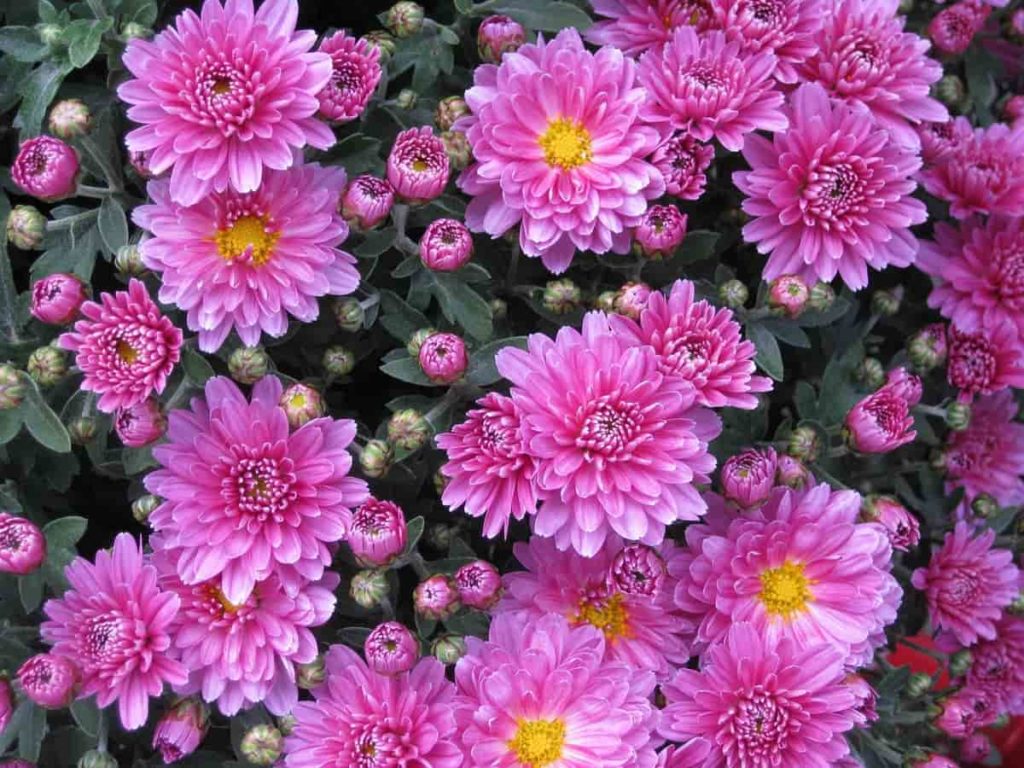
How often do mums bloom?
Whatever variety you have, most mums will bloom continuously for about four to eight weeks. It’s also important to pinch back the mums to encourage a longer flowering period. You’ll want to start by pinching them back when the plant is only 6 to 8 inches tall, then when it reaches 1 foot in height.
How do you care for Chrysanthemums?
Mums also need moisture for optimal growth. Constant watering in spring, summer, and fall is essential. After the ground freezes in the winter, watering can be stopped until the soil warms in the spring. Early morning watering is recommended at 6 to 8 inches.
Do Chrysanthemums prefer the sun or shade?
Chrysanthemums love the sun but can tolerate relatively little shade. They thrive in hardiness zones 5 to 9, and garden mums like lots of bright, direct sunlight, especially in the morning and early afternoon.
Do Chrysanthemums need a lot of water?
Chrysanthemums love the full sun, and all that heat means they need plenty of water. After repotting, give them a good soak, then water every other day or whenever the soil looks dry. Try to avoid wilting your plants.
Can you grow Chrysanthemums in pots?
Many people like to grow Chrysanthemums in their gardens, but you can also grow them indoors in pots. These plants can be grown in pots, which can be a great way to protect them from frost and other harsh winter conditions.
How do I get my Chrysanthemums to bloom more?
One secret to encouraging flowers on mums is to pinch them back. This means removing the initial buds with pruning. Cut back the top growth in the area where the front branches grow, and the plant will produce more stems and larger, fuller buds.
How do you promote blooming?
Flowers that re-bloom do not require much maintenance. To encourage re-blooming, deadhead blooms. In mid-summer, use a low-nitrogen fertilizer, such as 5-10-5. This high level of phosphorus promotes flowering.
How long do mums live after they bloom?
Although we usually think of fall as Chrysanthemum season, there are three different types of blooming mums: early bloomers, early fall bloomers, and late fall bloomers. Early bloomers often bloom in late July, early fall bloomers bloom in September, and late fall bloomers begin their spectacular display of color in October.
Each variety is different, but most mums bloom for four to eight weeks. There are many ways to grow Chrysanthemum flowers. Deadheading spent flowers, fertilizing in spring, and avoiding overcrowding will help your mums produce more flowers in the long run.
Do Chrysanthemums bloom every year?
Chrysanthemums are perennials, going dormant in winter, then regrowing in spring. Flowers come in different shapes, sizes, and colors.
How do you prune Chrysanthemums?
Chrysanthemums are reliable perennials that are probably growing in almost every garden. After Chrysanthemum plants bloom, you should cut them back to within six inches of the ground. Then you can dig up the bunches and cut the roots if you want to divide them.
In case you missed it: Hibiscus Grafting Methods; Pruning Time; Training
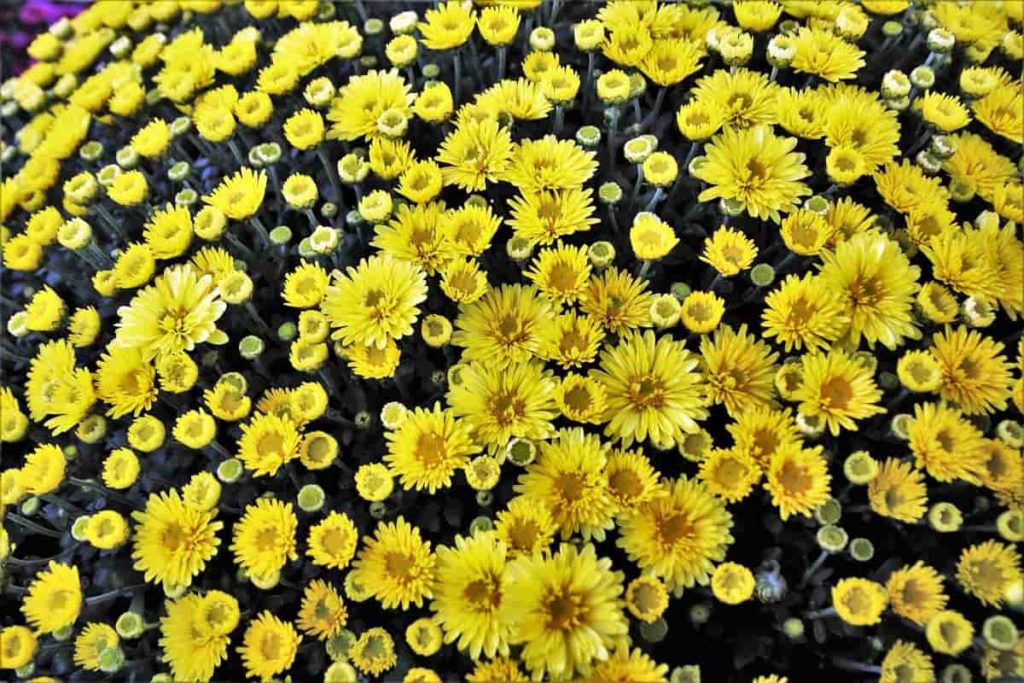
Conclusion
Mums, or Chrysanthemums, as they are officially known, have a limited flowering period. But a few key care secrets can extend their bloom time – and keep them looking stunning during the fall decorating season. Mums require proper care from the time you plant them in the spring to ensure excellent blooms later in the year.
Providing essential nutrients for optimal growth and sustaining flowers during the blooming period helps them flower profusely. There is hardly any other garden flower with a diverse and beautiful range of color shades, widely varying flower forms, and height ranges like Chrysanthemums.
- Types of Pesticides Used in Agriculture: A Beginner’s Guide
- Economical Aquaculture: A Guide to Low-Budget Fish Farming
- 15 Common Planting Errors That Can Doom Your Fruit Trees
- How to Make Houseplants Bushy: Effective Tips and Ideas
- Innovative Strategies for Boosting Coconut Pollination and Yield
- Pollination Strategies for Maximum Pumpkin Yield
- The Complete Guide to Chicken Fattening: Strategies for Maximum Growth
- Natural Solutions for Tulip Problems: 100% Effective Remedies for Leaf and Bulb-Related Issues
- Revolutionizing Citrus Preservation: Towards a Healthier, Greener Future
- Natural Solutions for Peony Leaf and Flower Problems: 100% Effective Remedies
- Maximizing Profits with Avocado Contract Farming in India: A Comprehensive Guide
- Natural Solutions for Hydrangea Problems: 100% Effective Remedies for Leaf and Flowers
- The Ultimate Guide to Choosing the Perfect Foliage Friend: Bringing Life Indoors
- From Sunlight to Sustainability: 15 Ways to Use Solar Technology in Agriculture
- The Ultimate Guide to Dong Tao Chicken: Exploring from History to Raising
- The Eco-Friendly Makeover: How to Convert Your Unused Swimming Pool into a Fish Pond
- Mastering the Art of Delaware Chicken Farming: Essentials for Healthy Backyard Flocks
- 20 Best Homemade Fertilizers for Money Plant: DIY Recipes and Application Methods
- How to Craft a Comprehensive Free-Range Chicken Farming Business Plan
- Brighten Your Flock: Raising Easter Egger Chickens for Beauty and Bounty
- How to Optimize Your Poultry Egg Farm Business Plan with These Strategies
- Subsidy for Spirulina Cultivation: How Indian Government Schemes Encouraging Spirulina Farmers
- Ultimate Guide to Raising Dominique Chickens: Breeding, Feeding, Egg-Production, and Care
- Mastering the Art of Raising Jersey Giant Chickens: Care, Feeding, and More
- Ultimate Guide to Raising Legbar Chickens: Breeding, Farming Practices, Diet, Egg-Production
- How to Raise Welsummer Chickens: A Comprehensive Guide for Beginners
- How to Protect Indoor Plants in Winter: A Comprehensive Guide
- Ultimate Guide to Grow Bag Gardening: Tips, Tricks, and Planting Ideas for Urban Gardeners
- Guide to Lotus Cultivation: How to Propagate, Plant, Grow, Care, Cost, and Profit
- Agriculture Drone Subsidy Scheme: Government Kisan Subsidy, License, and How to Apply Online
- Ultimate Guide to Raising Araucana Chickens: Breed Profile, Farming Economics, Diet, and Care
- Bringing Hydroponics to Classroom: Importance, Benefits of Learning for School Students
- Ultimate Guide to Raising Polish Chickens: Breed Profile, Farming Economics, Diet, and Care
- Ultimate Guide to Raising Australorp Chickens: Profile, Farming Economics, Egg Production, Diet, and Care
- Silkie Chicken Farming: Raising Practices, Varieties, Egg Production, Diet, and Care
- Sussex Chicken Farming: Raising Practices, Varieties, Egg Production, Diet and Care